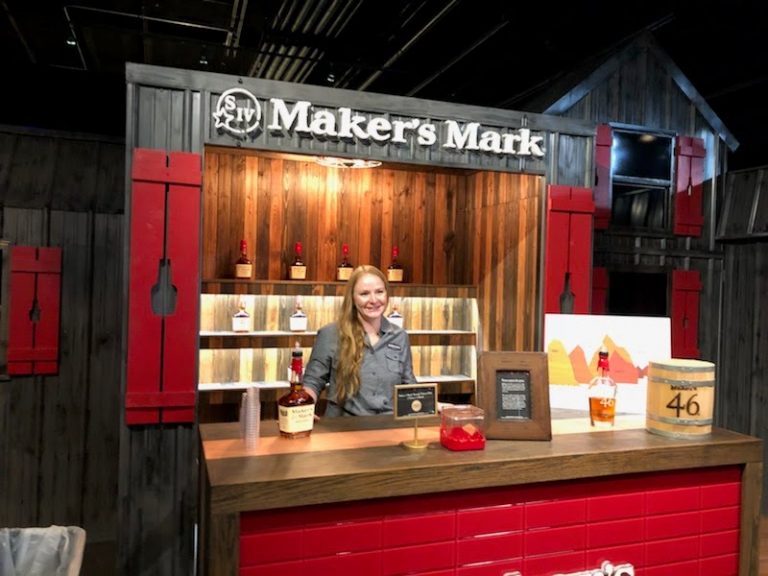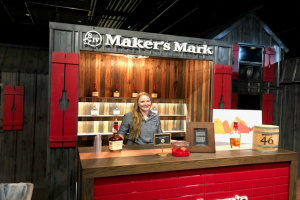11.10.18
By Lisa Major

Pop-up shops are popping up everywhere. These temporary spaces offer brands the opportunity to showcase their products or services, create buzz, and engage with consumers in an intimate setting. In this week’s Happy Hour, we lead off with an article that demonstrates the power of pop-ups, brands that have seen success with them, and tips for getting started. We’ll also take a look at the impact artificial intelligence is having on the events industry, why brands should be activating at festivals, and tips for building a better post-event recap.
“Innovative brands are always looking to set themselves apart from the crowd, and a pop-up shop is a prime way to do just that.” ~MC2
 Pop-up marketing continues to grow in popularity for brands. And with $45 to $50 billion in annual revenue, it’s easy to see why. Pop-up shops provide brands with a tremendous opportunity to create brand awareness in a unique and immersive space. While some marketers may be hesitant to jump on board for fear of the unknown, take this into consideration, “pop-up marketing requires less commitment than long-term retail, can be pulled off expertly with minimal cost, and has the potential to earn you and your brand major buzz.” From generating buzz to creating FOMO, pop-ups drive results. Here are 4 ways you can make pop-up marketing work for your business.
Pop-up marketing continues to grow in popularity for brands. And with $45 to $50 billion in annual revenue, it’s easy to see why. Pop-up shops provide brands with a tremendous opportunity to create brand awareness in a unique and immersive space. While some marketers may be hesitant to jump on board for fear of the unknown, take this into consideration, “pop-up marketing requires less commitment than long-term retail, can be pulled off expertly with minimal cost, and has the potential to earn you and your brand major buzz.” From generating buzz to creating FOMO, pop-ups drive results. Here are 4 ways you can make pop-up marketing work for your business.
“If you want to take a stab at this [experiential] marketing technique, keep these seven steps in mind as you consider, design, and implement your brand’s event.” ~Chris Roberts
Experiential marketing creates personal relationships with consumers, which drives results and has a direct effect on sales and brand loyalty. We can safely say that no other form of marketing can do that. And as more brands experiment with this highly effective marketing strategy, brands and marketers must ensure that they have a solid plan in place. There are a lot of moving parts, from design to logistics to event staffing and measurement, and building an effective experiential marketing campaign is a lot harder than one may think. There really is a never-ending list, not to mention, events, in general, can be a little volatile. Before you dive into your strategy, consider following this step-by-step plan to get the most out of your campaign.
“As you plan for 2019, think about what festivals might align with your brand. Consider creating an experiential brand activation to engage new potential customers.” ~Mark Whitehurst
 Before you know it, we will be ringing in the new year, and festival season will soon follow. Year after year, festival attendance continues to rise, giving brands the ultimate opportunity to connect with consumers in an already vibrant setting. From SXSW to beer festivals to music festivals and so many others, brands can cash in on the festival scene with brand activations and sponsorships. According to this study, 76% of festival attendees and 51% of all consumers say they feel more favorable toward brands that sponsor a tour or concert. That’s a pretty astounding statistic. As you begin to strategize for 2019, you should consider exploring the idea of a festival activation.
Before you know it, we will be ringing in the new year, and festival season will soon follow. Year after year, festival attendance continues to rise, giving brands the ultimate opportunity to connect with consumers in an already vibrant setting. From SXSW to beer festivals to music festivals and so many others, brands can cash in on the festival scene with brand activations and sponsorships. According to this study, 76% of festival attendees and 51% of all consumers say they feel more favorable toward brands that sponsor a tour or concert. That’s a pretty astounding statistic. As you begin to strategize for 2019, you should consider exploring the idea of a festival activation.
“AI can eliminate processes that normally create event space constriction, which ultimately creates a better experience for the attendee.” ~Tony Owen
 Whether you realize it or not, our daily lives are surrounded by artificial intelligence. From our pals Alexa and Siri making our grocery lists to Waze alerting us to traffic conditions, we rely on artificial intelligence to do a lot of things for us. The event industry is even tapping into AI to build better events, and make the attendee experience seamless, and more enjoyable. In this article, Becore shares a few ways that AI is impacting the industry.
Whether you realize it or not, our daily lives are surrounded by artificial intelligence. From our pals Alexa and Siri making our grocery lists to Waze alerting us to traffic conditions, we rely on artificial intelligence to do a lot of things for us. The event industry is even tapping into AI to build better events, and make the attendee experience seamless, and more enjoyable. In this article, Becore shares a few ways that AI is impacting the industry.
“By building a simple but strategic recap form, you’ll end up with a gold mine of information to share with your clients.” ~Jessica Plunkett
 As we mentioned above, there is so much that goes into planning an experiential marketing event. The time and effort spend on campaigns can be mind-boggling. Yet, there is one item that doesn’t get much thought, but it’s one of the most important components of your event. The post-event recap. Some of the most important and most accurate data will come from your post-event recap. Unfortunately, many agencies still use outdated strategies when it comes to recaps and reports. But with a little effort, you can turn your event recap into a powerful bank of information. One that is user-friendly, efficient, and effective. Here are a few considerations to help you build a better post-event recap that will not only make your brand ambassadors happy but will give you the information that you need to measure the effectiveness of your campaign.
As we mentioned above, there is so much that goes into planning an experiential marketing event. The time and effort spend on campaigns can be mind-boggling. Yet, there is one item that doesn’t get much thought, but it’s one of the most important components of your event. The post-event recap. Some of the most important and most accurate data will come from your post-event recap. Unfortunately, many agencies still use outdated strategies when it comes to recaps and reports. But with a little effort, you can turn your event recap into a powerful bank of information. One that is user-friendly, efficient, and effective. Here are a few considerations to help you build a better post-event recap that will not only make your brand ambassadors happy but will give you the information that you need to measure the effectiveness of your campaign.
Thanks for joining us for this week’s Happy Hour! We’ll see you again next week to discuss all the top news from the experiential and event marketing industry. Cheers!
Since 2002, countless brands and agencies have depended on ATN for their experiential staffing needs. We take pride in delivering top-notch service, from pre-event to post-activation, and every step along the way. Our staffing gurus are here to help you succeed.